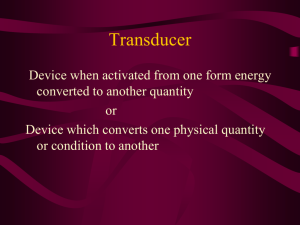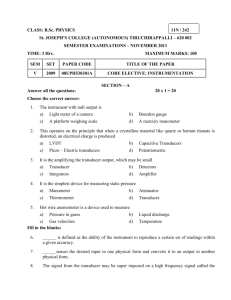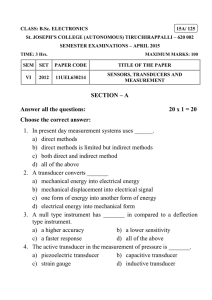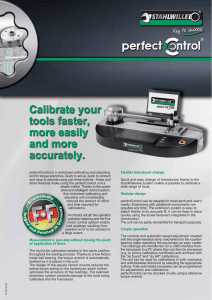laboratory manual
advertisement
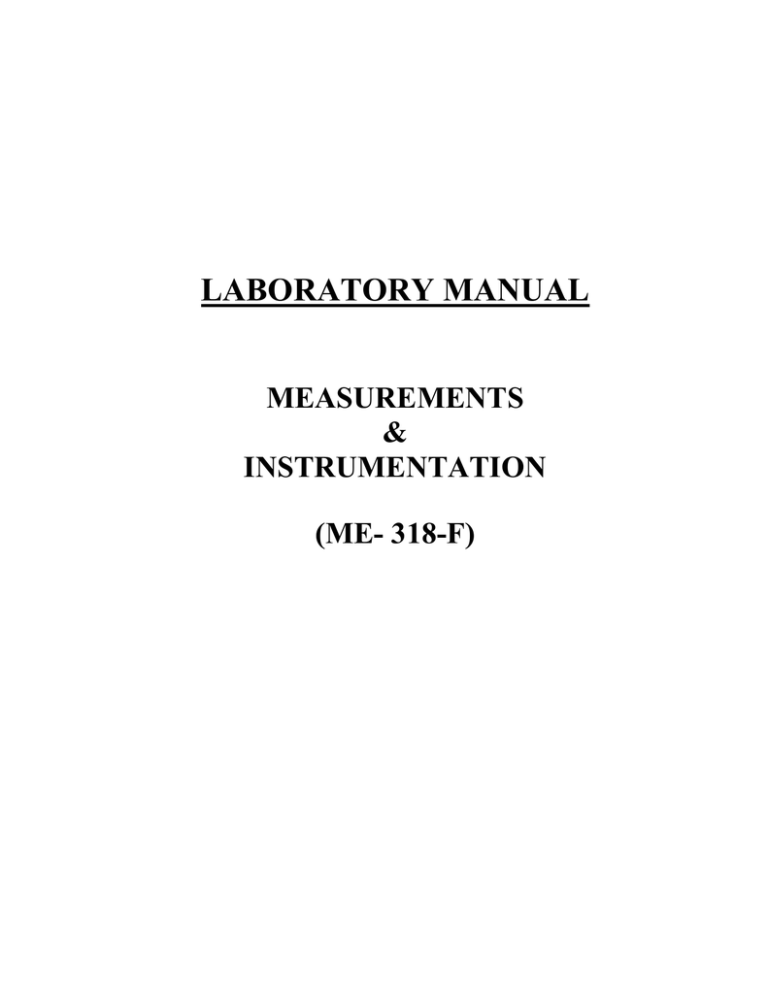
LABORATORY MANUAL MEASUREMENTS & INSTRUMENTATION (ME- 318-F) LIST OF THE EXPERIMENT S. NAME OF THE EXPERIMENT NO. PAGE NO FROM TO 1. To measure stress and strain using strain gauge mounted on a cantilever beam. 2. To measure the pressure of a fluid in a pipe using pressure transducer. 3. To Study the working of Bourdon Pressure Gauge and to check the calibration of the gauge in a dead-weight pressure gauge calibration set up. 4. To study Linear variable differential transformer (LVDT) and use it in a simple experimental setup to measure the height of meter in a tank. 5. To measure load using a load cell on a Tutor. 6. To measure the speed of a motor shaft with the help of non-contact type pick-ups (magnetic or photoelectric). 7. To measure torque of a rotating shaft using torsion meter/strain gauge torque transducer. 8. To Study various Temperature Measuring Instruments and to estimate their response times. 9. To Study variable capacitance transducers. 10. To study the Linear variable differential transformer (LVDT) accelerometer for measuring the vibrations. 11 Process Simulator 12 To find out transmission losses by a given transmission line by applying 13 Vibration measurement by Dual Trace Digital storage Oscilloscope. 14 To learn the methodology of pictorial representation of experimental data and subsequent calculations for obtaining various measures of true value and the precision of measurement using Data acquisition system/ calculator. capacitive /inductive load Note: 1. At least ten experiments are to be performed in the semester. 2. At least seven experiments should be performed from the above list. Remaining three experiments may either be performed from the above list or designed & set by the concerned institution as per the scope of the syllabus. EXPERIMENT NO 1 Objective: - To measure stress and strain using strain gauge mounted on a cantilever beam. Apparatus used: - Strain gauge Kit, cantilever beam weights, multimeter. Formula Used: - M / I = fs / y Where, M = force x ┴ distance (l) I = 1 / 12bd3 b = ……mm, l = ……..mm, d = …….. mm y = 1/2d Theory: Strain gauges are sensitive resistance which is based on principle that resistance of a conductor increases with the increase in length and decreases with increase in area. Strain gauges are of three types: 1. Foil type 2. Wire type 3. Semi conductor type Transducer: These are elements which convert desired input into more practical and convenient output. Procedure: 1. 2. 3. 4. 5. 6. 7. Arrange the cantilever beam, ammeter and voltmeter as shown in figure. After this, put the weight on the rod of cantilever beam. Measure the digital display reading for a particular weight. Measure the value of ammeter (along) and voltmeter reading (micro-volt) Increase the strength of weight. Repeat the steps for increased weight. Measure all dimensions of scale of cantilever. Precautions: 1. Place weight on cantilever beam carefully. 2. All joints should be tight & clean. 3. Note readings carefully. Result: 1. Display reading of stress 2. Calculated value of stress EXPERIMENT NO 2 Objective: - To measure the pressure of a fluid in a pipe using pressure transducer. Apparatus: - Pressure transducer Kit, multimeter etc. Theory: Strain gauges are sensitive resistances which are based on the principle that resistance of conductor increases with increases in length and decreases with increase in area. They are of three types: 1. Foil type 2. Wire type 3. Semiconductor type Transducer: Transducers are elements which convert desired inputs into more practical and convenient output. Procedure: 1. 2. 3. 4. 5. 6. 7. Firstly arrange the pressure transducer, Multimeter, Voltmeter. After that increase the pressure in the pressure transducer. Set the readings of pressure transducer on a particular reading. Now note the display reading on Kit. Also note the voltmeter & Ammeter readings. Repeat the numbers of reading with different pressure on transducer. Compare the value of pressure applied on transducer & display readings. Precautions: 1. All the connections should be neat & clean. 2. Pressure should be applied slowly on pressure transducer. Result: 1. Applied reading of pressure 2. Display reading of pressure EXPERIMENT NO 3 Objective: - To Study the working of Bourdon Pressure Gauge and to check the calibration of the gauge in a dead-weight pressure gauge calibration set up. Apparatus used: - Bourdon gauge Theory: It is an elastic element gauge. It is based on Hook’s law i.e. the deflection of the tip and deflection of the entire tube is proportional to the applied pressure. Some of the available types of Bourdon gauge are mainly four types: 1. C-Tube 2. Helical type 3. Spiral spring type 4. Twisted type (Slightly flat, Oval) The material chosen to fabricate a Bourdon tube will relate to the instant, sensitively, accuracy and precision material for Bourdon tube must have good elastic or spring characteristics. (a) For common pressure range (100-7000 Kg/cm2) → Phosphor Bronze (b) For higher range (7000-63000 Kn/m2) → Alloy steel The pressure responsive element of a Bourdon gauge consist essentially of a metal tube called ‘Bourdon Tube’. This tube is generally circular in cross-section. The tube is fixed at one end through this fixed end press to be applied is measured and the face end attain displacement under deforming action of the press difference. This end is connected to a spring loaded linkage which amplifies displacement and show it by a pointer on a calibrated scale. The linkage so designed for the mechanism, may be adjusted for optimum linearly and hysteresis and to compensate for mean when may develop after a period of time. A hair pin is some time used to fasten the spindle to the frame of instrument to provide necessary tension for proper machining. When the pressure to be measured is applied to the tube, its cross-section tends to become circular this makes the tube spin itself with an increase in the radius of curvature. In case of vacuum the oval tube would collapse and curve. The pointer connected to free end directly gives the reading of the pressure (units as scale). The linkage is so adjusted or designed that the mechanism may be adjusted for optimum linearity and hysteresis and to compensate for near which develop after a period of time. Working: When the press to be measured is applied to the tube, cross-section tends to become circular. This makes the tube straight itself with an increase in its radius of curvature. In case of vacuum, the oval tube would collapse & curve. The pointer connected to free end directly gives the reading. The approximate formula is angular difference of Bourdon Tube with elliptical cross-section are: ∆R/R = 0.05D / E x (R/E) 0.2 x (a/b) 6.33 x a3/t Where, R= Radius of tube t = Thickness of tube ∆R = Change in radius, major axis. Error and their Rectifications: Zero order error: This remains constant over the entire pressure range. This may be due the pointer on the range having spring which becomes loose on the spindle. This can rectified by keeping the pointer is correct position. Multiplication error: This error forms a wrong setting in the multiplying mechanism between the Bourdon tube and the spindle. To rectify the error the multiplication error is loosed & the connecting link is moved either a little toward or outward. Angularity error: It is seen that one to one when linear motions with link lever and pinion attachment to correct this error angularity error is adjusted. Advantages: • Low cost & simple construction. • Simple and straight forward calibration. • Available in several ranges. • Easy adapted to strain & transducer. Disadvantages: • Inherent hysteresis and low resistance to pressure change. • Required geared movement for application. • Susceptibility to shock & vibrations. Limitation: • Very expensive • The pipe must run full • The substance being measured must be conductive • As a zero checks on installation can be performed only by stopping the flow EXPERIMENT NO 4 Objective: - To study Linear variable differential transformer (LVDT) and use it in a simple experimental setup to measure the height of meter in a tank. Apparatus: - Linear variable differential transformer (LVDT), water level drains kit, multimeter etc. Theory: - Linear variable differential transformer (LVDT) the most widely used inductive transducer for translating the linear motion into electrical signals. A soft iron core provides the magnetic coupling between a primary coil and two secondary coils, connected in series opposition. When the core is central and both secondaries are identical, the voltages across them are equal in magnitude. However, the output is zero as both the secondaries are in series opposition. As the core moves up or down, the induced voltage of one secondary coil increases while that of the other decreases. The device is very sensitive and is linear over a wide range of motion. Construction and working: - It consists of a primary winding (P) and two identical secondary windings S1 and S2 wound over a hollow bob of non-magnetic and insulating material & have equal numbers of turns are placed either side of P attached to a sensing element. A soft iron core is of which displace is to be measured in the shape of a load slides freely in the hollow position of the bobbin. In either direction of movement of the core, difference of output voltage increases or decreases giving the idea of difference of movement. With the movement of core in one different away from null position differential output voltage of P and when in other direction output increases but 180° out of phase. Now by measuring the magnitude & comparing the phase of differential output voltage the primary voltage, amount & direction of displacement of core may be determined from the curve it is clear that this LVDT is linear for limited range of displacement, beyond that it starts flattering out at both ends, range of LVDT for displacement varies from ±0.01 mm to ±25mm. Procedure: 1. Arrange all the instruments respectively. 2. Fill the tank with water touching the scale height. 3. With the help of span knob adjust the zero reading. 4. Fill the tank with water to some height and note down the reading of height. 5. Repeat the procedure. 6. Compare actual and displaced values. Merits: 1. It has been infinite resolution. 2. No sliding parts, so some reliable device. 3. Output impedance of LVDT remains constant. 4. It has low hysterias & a good repeatability. 5. It consumes very less power. 6. Good frequency response. 7. It has almost linear characteristic. 8. It can tolerate shock & vibration. Demerits: 1. Sensitive to stay magnetic field. 2. Relatively large displacement required. 3. Sometimes, the transducer performance is affective by the vibration. Application: LVDT are suitable for use in applications where the displacements are too large for strain gauge to handle. There are often employed together other transducers for measurement of force, weight pressure etc. Precautions: 1. All connections should be neat & clean. 2. Water should be filled inside tank very slowly & carefully. Result: 1. Actual level of water : 5.0cm 2. Displacement level of water : 4.8mm EXPERIMENT NO 5 Objective: - To measure load using a load cell on a Tutor. Apparatus Used: - Load cell instrument, weights, data representation element (tutor). Introduction: Load cell is a device for measurement of force through indirect method. Load cell utilize on elastic member as the primary transducer and the strain gauge may be called as secondary transducer. Load cells are steel rings which are used as force standard. There are particularly useful for the calibration of material testing M/C in situations where dead weight standard are impractical to use on account of bulk m/c. If load cell is a circular ring which may be subjected to tensile or compressive forces across its diameter. In fact it is a ring in which the forces show a deflection relationship. Load cell is mainly of two types: • Hydraulic Load cell • Pneumatic Load cell Theory: In a hydraulic type of device (load cell), hydraulic pressure is used to indicate the force F, applied to a diaphragm or some other type of force transmitting element. Which force F is applied, pressure is developed in the fluid which is normally an oil. This can be measured by a pressure indicating device like a bourdon gage. Such a device can be used up to very large forces, of the order of millions of newtons. In pneumatic load cell air is supplied under pressure to a chamber having a diaphragm at one end and a nozzle at the other. Application of force to the diaphragm deforms it and changes the gap between the extension of the diaphragm and the nozzle, thus changing the pressure in the chamber. If force F increases, the gap reduces and this increases pressure p2 in the chamber. This increase in pressure produces a force tending to return the diaphragm to its original position. For any force F the system attains equilibrium and pressure P2 gives an indication of the force F. This type of load cell of load cell is used up to 20 kN. Procedure: • Make setup of load cell and tutor. • Place weight on the load cell. • Note down the reading given by tutor. • Take 8-10 readings by increasing weight. • Compare actual weight & weight given by tutor. Precautions: • All the connections should be neat & clean. • Note reading carefully Result: The compression of actual weight & weight indicated by tutor is given table. EXPERIMENT NO: 6 Objective: - To measure the speed of a motor shaft with the help of non-contact type pick-ups (magnetic or photoelectric). Apparatus: - DC Motor, photoelectric pick up kit, CRO connecting. Theory: There are electric tachometer consists of a transducer which converts rotational speed into an electrical signal coupled to an indicator. The transducer produces an electrical signal in proportion to speed. The signal may be in the analog form or in the form of pulses. Tachometer or pickups of this type produce pulses form a rotating shaft without being mechanically connected to it. As the energy produced by these devices is not sufficient to actual an indicator directly, amplifiers of sufficient sensitivity are employed. The various types of non-contact pick-ups are optical pick ups or photoelectric or photoconductive cell. • Electromagnetic pick up • Capacitive pick up Here we will measure the speed by optical pick up. As they don’t have moving parts so speed up to 3 million rpm. These are available in a variety of designs using the principle of shaft rotation to interrupt a beam of light falling on a photoelectric or photo conductive cell. The pulse thus obtained are first amplified & then either fed to an electric counter, or shaped to an along signal and connected to the indicator. A bright white spot is made on the rotating shaft. A beam of light originating from the tachometer case hits the white spot & the reflected light falls on photoconductive cell inside the case, producing pulse in transes torised amplifier, which is turn, causes the indicator to deflect which is measure of speed of the shaft. Formula used: - Speed (rpm) = Frequency x Diameter of Disk / No. of segments. Procedure and Precaution: 1. Connect the CKT & CRO with the required apparatus & switch on the supply. 2. Adjust the speed of the motor by the knob and wait for some time till the motor attains the maximum speed at corresponding knob position. 3. Measure the frequency from out put wave on CRO. 4. Find the speed of the motor. Calculations: - At knob position (A) RPM = (frequency) x diameter of disc/No. of teeth of segments N = PM = f x d / T Where f = 1/t Where t = time period of one cycle of out put wave & f = 1.8 x 2ms = 3.6 x 10-3 s [on CRO] and d = 56.5mm. Therefore, R.P.M = 2.79 x 102 x 56.5/ 60 = 262 rpm Result: - Speed of position ‘A’ = 262 rpm EXPERIMENT NO: - 7 Objective: - To measure torque of a rotating shaft using torsion meter/strain gauge torque transducer. Apparatus: - Torsion meter/strain gauge torque transducer. Introduction: - Instruments for measuring torque and power in rotating system. The power transmitted can be calculated from the torque, using the equation P=ωT Where, P is the power (in watts), T is torque (N m) ω is angular speed (rad / s). Devices used for power measurement are also known as dynamometers and may be classified into three types, depending on the nature of machine arrangement, for which torque or power is to be measured. The three types are: • Transmission type dynamometers, in which the power being transmitted through the device is measured. The device is neither a power generator nor a power absorber and is used on the shaft transmitting power, between the prime mover and the load. • Driving type dynamometer, in which drive is obtained from the dynamometer itself or the dynamometer is the power generator like an electric motor. • Absorption type dynamometer, in which mechanical energy is absorbed after it is measured. The power generator may be an engine or a motor. Theory & Working: - Angular twist θ in a shaft due to torque is given by equation T = G θπd4 / 32 L After measurement of θ, the torque ‘T’ can be easily calculated from the above relations. Either an electrical or optical arrangement can be used to measure θ. An optical arrangement is shown in the fig no 1. due to the transmission of torque, the two discs A and B mounted at a distance ‘L’ on the shaft, move relative to each other through an angle θ. This is recorded by the observer. Disc ‘C’ is only to help in viewing the relative angular displacement of A & B. Fig. no 2 shows an arrangement using toothed wheels are proximity sensors of electromechanical types. Two identical toothed wheels are fixed on the shaft at a certain distance. The two proximity sensors produce output voltage with phase difference proportional to torque. Alternatively, an arrangement using photo – cells and a light source may be employed. EXPERIMENT NO: 8 Objective: - To study various Temperature Measuring Instruments and to Estimate their Response times. • • • • Mercury – in glass thermometer Thermocouple Electrical resistance thermometer Bi–metallic strip Apparatus used: - Mercury–in glass thermometer, Thermocouple, Electrical resistance thermometer, Bi–metallic strip. Theory: Mercury – in glass thermometer: - The liquid – in – glass thermometer is one of the most common temperature measuring devices. Both liquid and glass expand on heating and their differential expansion is used to indicate the temperature. The lower temperature limit is – 37.8°C for mercury down to – 130°C for pentane. The higher temperature range is 340°C but this range may be extended to 560°C by filling the space above mercury with CO2 or N2 at high pressure thereby increasing its boiling point and range. Though the liquid – in – glass thermometer has certain laboratory applications, yet it is not much used industrially because of its fragility, and because of the inevitable proximity of the display to the measuring point. Thermocouple: - The most common electrical method of temperature measurement uses the thermo-electric sensor also known as the thermocouple. The construction of a thermocouple is quite simple. It consists of two wires of different metals twisted and brazed or welded together with each wire covered with insulation which may be either: 1. Mineral (magnesium oxide) insulation for normal duty, or 2. ceramic insulation for heavy duty When two conductors of dissimilar metals, say A and B are joined together to form a loop (thermocouple) and two unequal temperatures T1 and T2 are interposed at two junctions J1 and J2 respectively, then an infinite resistance voltmeter detects the electromotive force E or if a low resistance ammeter is connected, a current flow I is measured. Electrical resistance thermometer: - In resistance thermometers, the change in resistance of various materials, which varies in a reproducible – manner with temperature, forms the basis of this important sensing technique. The materials in actual use fall in two classes namely, conductors (metals) and semiconductors. In general, the resistance of the highly conducting materials (metals) increases with increase in temperature and the coils of such materials are called metallic resistance thermometers. Whereas the resistance of semiconductor materials generally (not always) decreases with increases in temperature. Thermo – sensitive resistors having such negative temperature characteristics are commonly known as NTC thermistors. Bi–metallic strip: - This type of thermometer also employs the principle of solid expansion and consists of a ‘bimetal’ strip usually in the form of a cantilever beam. This comprises strips of two metals, having different coefficients of thermal expansion, welded or riveted together so that relative motion between them is prevented. An increase in temperature causes the deflection of the free end of the strip, assuming that metal A has the higher coefficient of expansion. The deflection with the temperature is nearly linear, depending mainly on the coefficient of linear thermal expansion. Invar is commonly employed as the low expansion metal. This is an iron – nickel ally containing 36% nickel. Its coefficient of thermal expansion is around 1/20th of the ordinary metals. Brass is used as high expansion material for the measurement of low temperatures whereas nickel alloys are used when higher temperatures have to be measured. A plain bimetallic strip is somewhat insensitive, but the sensitivity is improved by using a longer strip in a helical form. One end of the helix is anchored to the casing and the other end which is free is conveniently connected to the pointer which sweeps over a circular dial graduated in degrees of temperature. Viva Questions: 1. What is Mercury – in glass thermometer? 2. What is Thermocouple? 3. What is Electrical resistance thermometer? 4. What is Bi–metallic strip? EXPERIMENT NO 9 Objective: - To Study variable capacitance transducers. Apparatus: - Capacitance transducer. Theory: A variable capacitance transducer works on the principal of change of capacitance may be due to it is a displacement sensitive transducer. Due to motion there is a change in the capacitance between two plates. Suitably circulating is used to generate a voltage corresponding to capacitance change. The capacitance between two plates is given by the equation C = 1/3.6π Є A/d Where, C= Capacitance in µ f A= Area of plate cm2 d= Distance between plates Є= dielectric constant of the medium between the plates Principal: The capacitance transducer is based on the principal of change of capacitance which may be caused by changed in 1. Area ‘A’ 2. By changing distance ‘d’ between plates 3. By changing the dielectric constant These changes are caused by physical variable like distance, force & pressure in most cases. The capacitance may be measured with a bridge CKT. The output impedance of capacitance transducer may be Xc = 1/2πfc Advantages: 1. They require very small force 2. They are extremely sensitive 3. Good frequency response 4. Loading effect is minimum 5. They are used where inductive transducer are ineffective due to magnetic field. Disadvantages: 1. They require insulation as its metallic parts are required to be earth. 2. The capacitance transducer shows non linear behavior which may be an account of edge current. Viva Questions: 1. What are variable capacitance transducers? 2. What are the changing base principals of capacitance transducers? 3. What are the disadvantages of variable capacitance transducers? 4. What are the advantages of variable capacitance transducers? EXPERIMENT NO 10 Objective: - To study the Linear variable differential transformer (LVDT) accelerometer for measuring the vibrations. Apparatus Used: - Accelerometer trainer kit. Introduction: The condition of the machines may be determined by physical parameters like vibration, noise, temperature, oil contamination, wear debris etc. A change in any of these parameters, called signatures, would thus indicate a change in the condition or health of the machine. If the properly analyzed, this thus becomes a valuable tool to determine when the machine needs maintenance and in the prevention of machinery failures, which can be catastrophic and result in unscheduled break – downs. Vibration or noise signature of a machine is seen to very much relate to the health of a machine. Thus, measurement of vibration levels on bearing housing, relative movement between shaft and bearing, noise emitted by a machine. Theory: Accelerometer is used for different requirements of range of natural frequency (NP) and damping. The specification sheet for an AM gives the NF & OR and a scale factor which relates output with the accelerometer input. It is used for vibration, shock and general absolute motion. It is seismic transducer and used in acceleration mode. Fig. no. 1 shows an AM using two flexible LVDT. The core of LVDT acts as the mass of two flexible reeds attached at the end of rod of core provided necessary spring action. The reeds attached to housing which is subjected to vibrations. This is necessary in order that the core of LVDT is maintained at the null position. As the sensor (core) moves up and down on account of vibration. The LVDT secondary gives an AC output, first of one phase and then after directly of the opposite phase. The magnitude of this o/p signal depends upon the vibrations. The signal may then rectified producing a volt that alternatively is -ve or +ve. By measuring peak magnitude of this voltage. An indication of amplitude of vibration may be obtained. They are used for steady state and low frequency vibration measurement. Errors:• Amplitude and phase is seismic system. • Contact resource. • Faulty mounting of velocity vibration pick up. • Crinkles (frequency v/s amplitude). • Influence of the pick up on the vibration objective. • Disturbances CRO. Advantage:• LVDT has a higher natural frequency due to small mass therefore can be used for vibration of higher frequency. • It offers a lower resistance to the motion then the potentiometer and is capable of a much better resolution. • It is a contact less device and is therefore free from problems which arise on account of mating parts. Viva Question: 1. Why Accelerometer is used? 2. What are the merits of LVDT? 3. What are the demerits of LVDT? 4. What are the advantages of LVDT?
